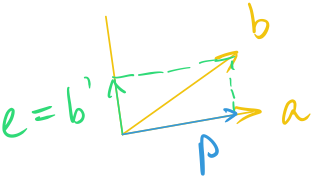Orthogonal Matrices and Gram-Schmidt
June 4, 2019
Orthonormal vector: Vectors are orthonormal iff
This is saying these vectors are orthogonal to all the others, and they are normalized to have length one (unit vector). One example is . But note that this is not the only example. Let the matrix
Then
You can call the matrix orthonormal matrix, which is a less known name. But when is square, it’s an Orthogonal Matrix. The orthogonal matrix has the following property
Some examples of are permutation matrix , or
Projection into C(Q)
As long as we use the notation , it implies that the columns of are orthonormal, but not necessary unit vectors. Recall from our projection matrix formula:
And recall when a matrix is full rank, ’s inverses can be factored out and we got identity matrix on . This is saying we are projecting into nowhere, the vector is staying at the original space. is by definition equal to ; and when is square/ is an orthogonal matrix, . And remember ,
Gram-Schmidt
Let’s try to make a matrix’s columns orthonormal. For two arbitrary vectors , we want to find s.t. . And ’s unit vectors are . To do so we need projections. Remember projected vector is onto the space of , and there’s an error/difference . This error is in the , and it is perpendicular to the projected vector. This is what we want. (In this case )

To verify, should be equal to 0:
This can be generalized from vectors to a plane or a space.
A =QR
…